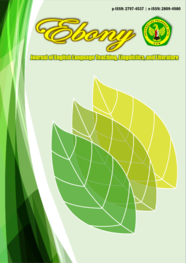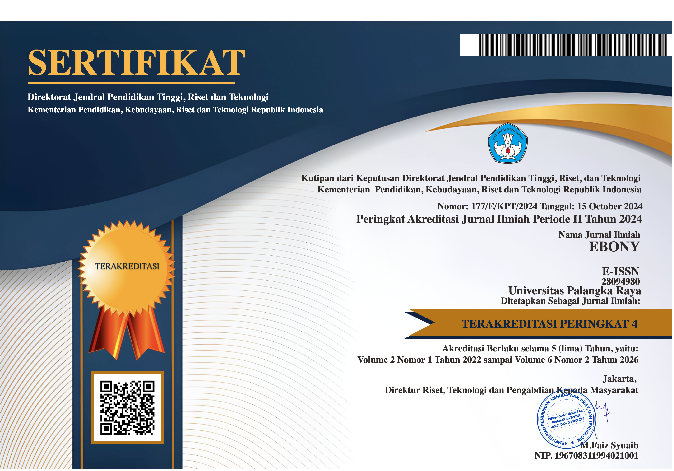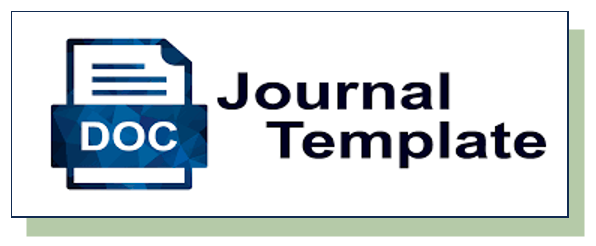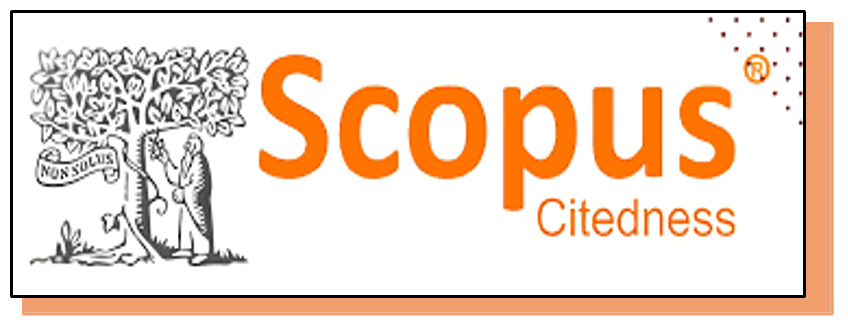An Authenticity Analysis of Reading Materials in an EFL Textbook
DOI:
https://doi.org/10.37304/ebony.v5i2.20732Keywords:
authenticity, EFL textbook, reading materials, English for NusantaraAbstract
This research examines the authenticity of reading materials in the English for Nusantara untuk SMP/MTs Kelas IX textbook, using Pinner’s (2014) authenticity continuum theory as the analytical framework. The research employs a descriptive qualitative design through document analysis of five selected reading materials. Seventeen indicators across four dimensions, individual relevance, target language community, classroom applicability, and real-world connection, were used to assess the materials. The findings reveal that the textbooks perform well in terms of structural and pedagogical authenticity, demonstrated by reading materials that are aligned with the curriculum, appropriate to the students' level, and engaging. However, the analysis also revealed a lack of cultural references, real-world content, and opportunities for student interaction, which are crucial for developing communicative competence and cross-cultural awareness. Overall, the textbook offers partially authentic reading materials. It is recommended that future textbook revisions include richer cultural content and more interactive tasks to connect language learning with real-life communication and global contexts.
Downloads
References
Abatayo, J., Parina, J. C., & De Leon, K. (2023). Authenticity, Believability, and Cultural Accessibility of Listening Texts: An Exploratory Study in Omani Classrooms. Mextesol Journal, 47(1), 0–3. https://doi.org/10.61871/mj.v47n1-8
Abdulhay, H. (2024). Authenticity of Discourse Markers and Features in Iranian School English Textbooks. Journal of Applied Linguistics Studies, 3(1), 19–36. https://oiccpress.com/jals/article/view/5590
Ahmad, H., & McColl Millar, R. (2020). Reviewing Definitional Ambiguities and Significance of Text Authenticity in English Language Teaching. Humanities & Social Sciences Reviews, 8(4), 01–09. https://doi.org/10.18510/hssr.2020.841
Al-Saeed, S. J., & Alenezi, A. A. (2021). Assessing the Communicative Use of Literary Texts in EFL Coursebooks. English Language and Literature Studies, 11(2), 68. https://doi.org/10.5539/ells.v11n2p68
Al Khazaleh, S. (2020). A Content Analysis of the Authenticity of the Reading Texts in the Seventh Grade EFL Book in Jordan. International Online Journal of Education and Teaching, 7(3), 977–990. https://iojet.org/index.php/IOJET/article/view/872
Almalki, M., ALzahrani, S., & Al-Olaqi, F. M. T. (2024). Merits and Demerits of English Language Coursebook Designs: A Scoping Review. Journal of English Language Teaching and Applied Linguistics, 6(2), 73–79. https://doi.org/10.32996/jeltal.2024.6.2.9
Alshumaimeri, Y. A., & Alzyadi, M. S. (2015). Using Material Authenticity in the Saudi English Textbook Design: A Content Analysis from the Viewpoint of EFL Teachers. Advances in Language and Literary Studies, 6(2), 229–241. https://doi.org/10.7575/aiac.alls.v.6n.2p.229
Arsah, A. A., Kalisa, P., & Miningsih, S. (2023). The Implementation of Flash Cards to Improve VII A SMPN 2 Dempet Students’ Vocabulary Mastery of Narrative Text in Academic Year of 2022/2023. UNNES-TEFLIN National Conference, 133–137. https://proceeding.unnes.ac.id/utnc/article/view/2603
Ary, D., Jacobs, L. C., Razavieh, A., & Sorensen, C. K. (2009). Introduction to Research in Education (8th ed.). Cengage Learning. https://spada.uns.ac.id/pluginfile.php/514264/
Belet Boyacı, Ş. D., & Güner, M. (2018). The Impact of Authentic Material Use on Development of the Reading Comprehension, Writing Skills and Motivation in Language Course. International Journal of Instruction, 11(2), 351–368. https://doi.org/10.12973/iji.2018.11224a
Berardo, S. A. (2006). The Use of Authentic Materials in the Teaching of Reading. The Reading Matrix: An International Online Journal, 6(2), 60–69. https://readingmatrix.com/articles/berardo/article.pdf
Byram, M. (2012). Language Awareness and (Critical) Cultural Awareness – Relationships, Comparisons and Contrasts. Language Awareness, 21(1–2), 5–13. https://doi.org/10.1080/09658416.2011.639887
Çakmak, Z., & Ersanli, C. Y. (2021). A Corpus-Based Study on the Authenticity of Dialogues in the B1-B2 Levels ELT Coursebooks Used in Turkey. International Journal of Curriculum and Instruction, 13(3), 3212–3230. https://www.ijci.net/index.php/IJCI/article/view/814
Castillo Losada, C. A., Insuasty, E. A., & Jaime Osorio, M. F. (2017). The Impact of Authentic Materials and Tasks on Students’ Communicative Competence at a Colombian Language School. PROFILE Issues in Teachers’ Professional Development, 19(1), 89. https://doi.org/10.15446/profile.v19n1.56763
Chien, C. W. (2020). Analysis of Taiwanese Pre-Service Teachers’ Perceptions of Activity Designs on School-Based English Camps for Elementary School EFL Learners. Innovation in Language Learning and Teaching, 14(2), 188–201. https://doi.org/10.1080/17501229.2018.1549553
Cunningsworth, A. (1995). Choosing Your Coursebook. Cambridge University Press. https://fliphtml5.com/pleb/ywab/basic
Dezheng (William) Feng. (2022). Changing Authenticity in English Language Textbooks in Hong Kong: An Ontogenetic Analysis. English as a Foreign Language International Journal, 2(6), 105–122. https://doi.org/10.56498/424262022
Fauzi, I., Saman, T. N., Zannah, N., Octaviani, S., & Winey, B. G. (2022). The Relationship Between Students’ Reading Motivation and The Success to Comprehend the English Texts. Journal of English Teaching and Learning Issues, 5(1), 31-38.
Febriana, M., & Panuntun, I. A. (2021). The Authenticity of Reading Activities Using Brown’s Model in 12th Grade English Textbook. JELLE : Journal Of English Literature, Linguistics, and Education, 2(2), 7–8. https://doi.org/10.31941/jele.v2i2.1706
Gardner, R. C. (2001). Language Learning Motivation: The Student, the Teacher, and the Researcher. Texas Papers in Foreign Language Education, 6(1), 1–18. https://eric.ed.gov/?id=ED464495
Ghafar, Z. (2024). The Impact of Electronic Books on Learning English Language in the Digital Era: An Overview. Journal of Digital Learning and Distance Education, 2(7), 635–644. https://doi.org/10.56778/jdlde.v2i7.184
Ghorbani Shemshadsara, Z., Ahour, T., Hadidi Tamjid, N., & Heidari-Shahreza, M. A. (2019). Raising Text Structure Awareness: A Strategy of Improving EFL Undergraduate Students’ Reading Comprehension Ability. Cogent Education, 6(1), 1644704. https://doi.org/10.1080/2331186X.2019.1644704
Gilmore, A. (2007). Authentic Materials and Authenticity in Foreign Language Learning. Language Teaching, 40(2), 97–118. https://doi.org/10.1017/S0261444807004144
Guariento, W., & Morley, J. (2001). Text and Task Authenticity in the EFL Classroom. ELT Journal, 55(4), 347–353. https://doi.org/10.1093/elt/55.4.347
Hossain, K. I. (2024). Reviewing the Role of Culture in English Language Learning: Challenges and Opportunities For Educators. Social Sciences & Humanities Open, 9, 100781. https://doi.org/10.1016/j.ssaho.2023.100781
Huang, P. (2019). Textbook interaction: A Study of the Language and Cultural Contextualisation of English Learning Textbooks. Learning, Culture and Social Interaction, 21, 87–99. https://doi.org/10.1016/j.lcsi.2019.02.006
Hyland, K. (2016). Methods and Methodologies in Second Language Writing Research. System, 59, 116–125. https://doi.org/10.1016/j.system.2016.05.002
Kimsesiz, F. (2023). An Examination of Text Authenticity in English Language Coursebooks for Secondary School Learners. 18(3), 925–943. https://doi.org/10.7827/TURKISHSTUDIES.71327
Knapp, P., & Watkins, M. (2005). Genre, Text, Grammar: Technologies for Teaching and Assessing Writing. UNSW Press. https://tesl-ej.org/pdf/ej66/r2.pdf
Lave, J. (1991). Situating Learning in Communities of Practice. In Perspectives on Socially Shared Cognition. (pp. 63–82). American Psychological Association. https://ecologyofdesigninhumansystems.com/
Li, M., & Chen, Y. (2025). In the Wild? Evaluating the Authenticity of Conversation Openings and Closings in EFL/ESL Textbooks. Linguistics and Education, 86(January), 101392. https://doi.org/10.1016/j.linged.2025.101392
Liddicoat, A. J., & Scarino, A. (2013). Intercultural Language Teaching and Learning. Wiley. https://doi.org/10.1002/9781118482070
Littlejohn, A. (2012). Language Teaching Materials and the (very) Big Picture. Electronic Journal of Foreign Language Teaching, 9(1), 283–297. https://e-flt.nus.edu.sg/v9s12012/littlejohn.pdf
Lowe, R. J., & Pinner, R. (2016). Finding the Connections Between Native-Speakerism and Authenticity. Applied Linguistics Review, 7(1), 27–52. https://doi.org/10.1515/applirev-2016-0002
Luis, A. R. (2024). Examining Adaptation Practices in English Language Textbooks: A Closer Look at Authenticity. Journal of English Studies, 22, 199–218. http://doi.org/10.18172/jes.5932
Mishan, F. (2005). Designing Authenticity into Language Learning Materials. Intellect. https://doi.org/10.1017/S0958344007000717
Namaziandost, E., Razmi, M. H., Ahmad Tilwani, S., & Pourhosein Gilakjani, A. (2022). The Impact of Authentic Materials on Reading Comprehension, Motivation, and Anxiety Among Iranian Male EFL Learners. Reading and Writing Quarterly, 38(1), 1–18. https://doi.org/10.1080/10573569.2021.1892001
Nation, I. S. P. (2001). Learning Vocabulary in Another Language (Vol. 10). Cambridge University Press. https://doi.org/10.1017/CBO9781139524759
Nunan, D. (2012). Learner-Centered English Language Education. Routledge. https://doi.org/10.4324/9780203096888
Nyimbili, F., Namuyamba-kabika, M., & Chakanika, W. (2018). The Use of Learner Centered Techniques in the Teaching of English Language in Selected Secondary Schools of Lundazi District. International Journal of Humanities, Social Sciences and Education, 5(3), 143–149. https://doi.org/10.20431/2349-0381.0503015
Pesiwarissa, R., Anaktototy, K., & Maruanaya, H. J. (2021). An Analysis of EFL Teacher-Made Tests. MATAI: International Journal of Language Education, 2(1), 1–13. https://doi.org/10.30598/matail.v2i1.5485
Pinner, R. (2014). The Authenticity Continuum: Towards a Definition Incorporating International Voices. English Today, 30(4), 22–27. https://doi.org/10.1017/S0266078414000364
Rahman, U. M., Abbas, M. M., & Ridha, H. A. M. (2022). A Content Analysis of the Literary Texts’ Authenticity in Students’ English Textbooks “English for Iraq” of Iraqi Preparatory Schools. Res Militaris, 12(2), 3037–3049. https://cdnx.uobabylon.edu.iq/research/6HUmb5DEPEyMFr1kIUQ.pdf
Richards, J. C. (2001). Curriculum Development in Language Teaching. Cambridge University Press. https://doi.org/10.1017/CBO9780511667220
Sari, A. J. C., Mujiyanto, J., & Rukmini, D. (2022). Assessing the Use of Cohesive Devices in Reading Texts of English Textbook. English Education Journal, 12(2), 264–273. https://doi.org/10.15294/eej.v12i2.56996
Sarivah, V., & Ambarwati, E. K. (2023). An Analysis of the English Textbook “My Next Word Grade 4” for the Elementary School. Jurnal Pendidikan Dan Konseling, 4, 1349–1358. https://journal.universitaspahlawan.ac.id/index.php/jpdk/article/view/11559
Sasson, D. (2007). Six Tips for Teaching Lower Level Junior High School ESL Students. The Internet TESL Journal, 8(7). http://iteslj.org/Techniques/Sasson-LowerLevelJHS.html
Sayi, B. (2024). English Language Taechers’ Perspectives on the Integration of Authentic Reading Materials in Reading Class. International Journal of Linguistics, Literature and Translation (IJLLT), 7(6), 143–151. https://doi.org/10.32996/ijllt
Sihombing, T. H. J., & Nguyen, M. X. N. C. (2025). Cultural Content of an English Textbook in Indonesia: Text Analysis and Teachers’ Attitudes. Asian Englishes, 27(1), 227–249. https://doi.org/10.1080/13488678.2022.2132131
Syahid, A., Safitri, A., Jumiati, N., Nurindraswari, R. A., Azizah, N. N., & Jubaidah, S. (2024). The Examining of Effectiveness English Textbook in Indonesian New Curriculum for Elementary School. Jurnal Ilmiah Multidisiplin, 3(03), 51–56. https://doi.org/10.56127/jukim.v3i03.1258
Taguchi, N. (2015). “Contextually” Speaking: A Survey of Pragmatic Learning Abroad, in Class, and Online. System, 48, 3–20. https://doi.org/10.1016/j.system.2014.09.001
Tomlinson, B. (2012). Materials Development for Language Learning and Teaching. Language Teaching, 45(2), 143–179. https://doi.org/10.1017/S0261444811000528
Treve, M. (2023). Examining The Impact Of Using Authentic Materials On Esl/Efl Learners. International Journal of Empirical Research Methods, 1(1), 40–50. https://doi.org/10.59762/ijerm205275791120231005151352
Ushioda, E., & Dorniey, Z. (2017). Beyond Global English: Motivation to Learn Languages in a Multicultural World: Introduction to the Special Issue. The Modern Language Journal, 101(3), 451–454. https://doi.org/10.1111/modl.12407
Van Compernolle, R. A., & McGregor, J. (2016). Authenticity, Language and Interaction in Second Language Contexts. Multilingual Matters. https://dokumen.pub/authenticity-across-languages-and-cultures-themes-of-identity-in-foreign-language-teaching-and-learning-9781800411050.html
Widodo, H. P. (2018). A Critical Micro-semiotic Analysis of Values Depicted in the Indonesian Ministry of National Education-Endorsed Secondary School English Textbook. In Situating moral and cultural values in ELT materials: The Southeast Asian context (pp. 131–152). Springer. https://doi.org/10.1007/978-3-319-63677-1_8
Winarti, M., Faridi, A., & Rozi, F. (2021). Evaluating the Validity, Reliability and Authenticity of English Achievement Test for the Twelfth Grade Students of SMAN 4 Tebo, Jambi. English Education Journal, 11(1), 130–138. https://doi.org/10.15294/eej.v11i1.44176
Yelni, M. S., & Elismawati. (2021). The Authenticity of English Material in Think Globally Act Locally for Elt Writing Instruction At Islamic Junior High. Research in English Language Teaching, 7, 29–44. https://ejournal.uinib.ac.id/jurnal/index.php/rielt/article/view/3964/0
Yunus, M. M., Salehi, H., & John, D. S. A. (2013). Using Visual Aids as a Motivational Tool in Enhancing Students Interest in Reading Literary Texts. Proceedings of the 4th International Conference on Education and Educational Technologies (EET ’13), 114–117. https://doi.org/10.48550/arXiv.1305.6360
Downloads
Published
How to Cite
Issue
Section
License
Copyright (c) 2025 Syarifah Nur Halima

This work is licensed under a Creative Commons Attribution 4.0 International License.











